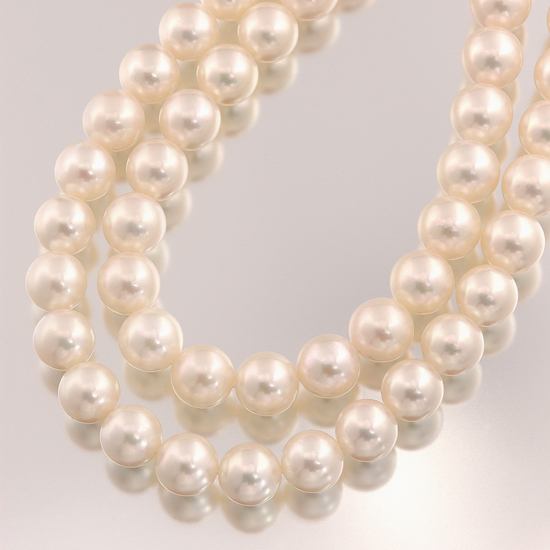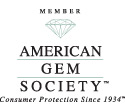The Pearl Farms of Japan- Going, Going, G….
June 13th, 2009 by James L. Sweaney, CGA, FGA. GG
Double Akoya Strand
An article I noted in the current AGTA ePrism newsletter refers to the challenges facing the Japanese saltwater cultured pearl industry. Prior to my career with Mardon Jewelers, I worked with John Latendresse, the creator of the American Freshwater Cultured Pearl, and learned firsthand just how difficult, labor intensive and risky the pearl culturing business really is. Sadly, today’s toxic economic environment is the final blow to many Japanese pearl farms.
A pearl farm anywhere is really like a roulette wheel. The pearl grower places enormous bets in hopes of generating a crop of pearls that will yield enough money to pay for his production costs and keep his farm afloat for next year’s production. To produce the pearls, he must pay for water rights, pearl rafts, tender boats, live molluscs, shell bead nucleii, operating tools and medicines for the nucleating process, and the labor to nucleate, tend and protect the mother shells and their precious cargo thru the long growing season. Then, he must sell his pearls.
In Japan, the risks are bad weather, disease, red tide, pirates, overcrowding, pollution, financing, falling markets and intense competition from pearl farms in China and elsewhere. Small wonder the children of the pearl farmers of Japan don’t want to live on the water anymore and are mostly choosing other occupations.
Building on his early discoveries of pearl culturing, the famous Kokichi Mikimoto fathered a major aquaculture industry that has been the pride of Japan for almost a century. His pearl farms were built around a technology that depends on a successful surgery on the body of a living creature. To grow a round pearl, Mikimoto’s method was to surgically implant a round mother of pearl bead (the kaku) into the gut of the pearl oyster. Then, the oyster would coat the bead with nacre.
Mikimoto’s livestock of choice was the Pinctada fucata pearl oyster/mollusc, common and indigenous to Japan where it is known as the Akoya. Ever the promoter, Mikimoto employed the Ama, the women divers of Japan, the bring up the Akoya to stock his farms and to publicize his venture–the Ama were famous for diving topless.
The good news about the Akoya mollusc is that it produces a finely textured nacre. This is partly because of the inherent nature of the Akoya, partly because of the cool waters of the Sea of Japan. The Akoya produces nacre slowly and the mineral crystals within the nacre are smaller, resulting in pearls that are much more lustrous than South Sea pearls.
The bad news is that the Akoya is a rather delicate creature. Even with today’s modern antibiotics and medicines, the survival rates for the Akoya after nucleation are still low. As a rule, fifty out of one hundred implanted oysters will either die or reject the pearl nucleus. Out of the remaining 50%, 15% will not meet minimum export standards, and only 5-10% yield top quality pearls. Early on, Mikimoto made a big show out of burning the pearls that did not meet his industry’s high standards for quality for export.
For years, the Japanese growers have raised their own Akoya to selectively breed them for better luster. Indeed, wild stocks have diminished and are expensive. Unfortunately, the purebred oysters lack the vigor of the native shells and are susceptible to disease.
Water quality and availability has become an issue. Along with increased demand for space in Japan’s crowded bays, pollution and periodic toxic red tides take their toll on the farmer’s delicate crop.
So it’s really a numbers game, and the numbers are winning. Japanese pearl growers, known for their high quality standards, are succumbing to steadily diminishing returns as the market turns to lower cost producers in China. The famous Japanese cultured pearl is disappearing from the market place–who knows if it will return. Fortunately, others with a passion for pearls have planted their crops and are waiting hopefully for the new harvest.
Tags: Akoya, kaku, pearl culturing, South Sea Pearls








March 3rd, 2010 at 12:16 pm
Hi Jim,
We at the GIA library enjoyed reading your recent post on pearls. I remember the excellent lecture you gave to the GIA staff in Santa Monica about cultured pearl farming.
All the best,
Dona Dirlam
Check out the GIA website. All week we are celebrating Richard T. Liddicoat week and we remembered his birthday yesterday.